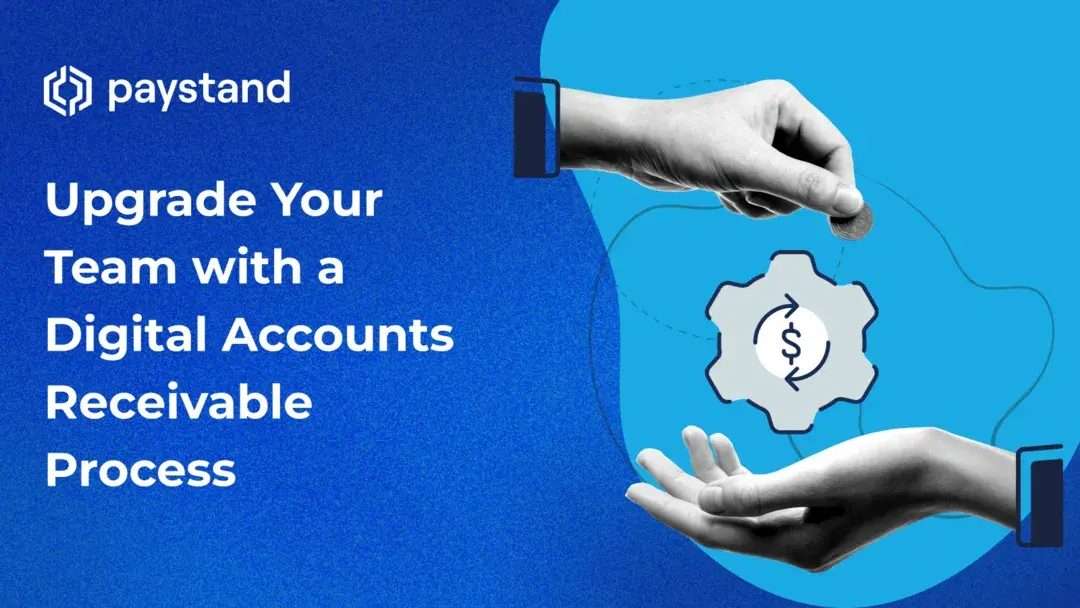How Much Impact Can a Digital Accounts Receivable Process Have?

Table of Contents
- How to Transform Accounts Receivable Digitally
- 3 Signs You Should Switch to a Digital AR Process
- Streamline AR Processes with Digital Transformation
- AR Transformation for Enhanced Cash Flow Management
- Innovative AR Digital Transformation Strategies
- Best Software for Accounts Receivable Transformation
Key Takeaways
- Manual accounts receivable (AR) processes cost time, money, and growth opportunities.
- Digital AR transformation improves cash flow, reduces DSO, and enhances the customer experience.
- Automating financial operations can reduce overhead costs by 33% and manual tasks by up to 70%.
- Real-time data and insights from digital AR tools help drive better decisions across departments.
- Platforms like Paystand offer a path to transformed accounts receivable and zero-fee payment rails.
Unlocking the potential of a streamlined and efficient accounts receivable process is critical for finance teams burdened by paperwork, manual tasks, and fragmented data sources. If your accounting processes are still stuck in the manual era, it may be time to re-evaluate your financial operations strategy.
Up to 25% of revenue from new sales can be lost due to poor billing and AR processes. Disparate systems, late payments, and paper invoicing lead to delays, inefficiencies, and limited capital liquidity. Finance teams are drowning in the administrative drag of an outdated process.
But there is a better way: a digitized, automated, and data-driven approach to AR.
How to Transform Accounts Receivable Digitally
Digital transformation in AR isn’t just about sending invoices electronically. It’s about rethinking the entire workflow—how invoices are created, delivered, paid, and reconciled.
Modern AR platforms help:
- Automate invoicing and reminders
- Enable real-time payment tracking
- Improve the customer experience with embedded payment links
- Integrate directly with your ERP and accounting software
Finance teams using a digital AR strategy have doubled output while cutting costs by a third. These transformed accounts receivable processes free up your team for high-value work like forecasting and strategic planning.
3 Signs You Should Switch to a Digital AR Process
If these pain points sound familiar, your accounts receivable team is due for an upgrade:
- Excessive Time on Invoicing: 37% of organizations spend between 41 and 160 hours per month handling unpaid invoices.
- Overstaffed for Receivables: 41% have more than five people focused on AR.
- Touchpoints Are Too High: Nearly all invoices require at least one follow-up.
A digital transformation streamlines these efforts and unlocks better financial operations.
Streamline AR Processes with Digital Transformation
Digitizing AR isn’t just about speed—it’s about accuracy, consistency, and scale. Whether you're a mid-sized company or a fast-growing enterprise, digital tools eliminate unnecessary touchpoints and reduce manual entry errors.
You’ll be able to:
- Cut repetitive tasks by up to 70%
- Automate reminders and follow-ups
- Deliver invoices that are easy to access and act on
- Gain real-time visibility into receivables
This frictionless approach helps ensure nothing slips through the cracks, and customers appreciate the smoother experience.
AR Transformation for Enhanced Cash Flow Management
Reducing Days Sales Outstanding (DSO) is one of the most impactful ways to improve cash flow. But chasing down payments manually drains resources. AR automation eliminates much of the busywork.
Digital AR platforms can:
- Track aging receivables in real time
- Automatically escalate follow-ups for overdue invoices
- Provide insights into payer behavior and risk
These insights support stronger forecasting and better accounts receivable management.
Innovative AR Digital Transformation Strategies
Moving beyond digitization into full automation requires strategic planning. Here are three core strategies for success:
1. Digitize All AR Records
Go paperless. Store customer data, purchase orders, and invoices in a centralized platform. Enable digital invoice delivery and online payment options. This alone can reduce AR labor costs and errors substantially.
2. Automate Around Digital Inputs
Digitization without automation still leaves gaps. Ensure your platform connects invoice generation, payment collection, and reconciliation workflows. Tools like Paystand let you auto-generate invoices, link payments, and reconcile instantly—no human intervention needed.
3. Use Data to Drive Strategy
Once digitized and automated, use AR data to inform decisions:
- Who pays late—and why?
- What triggers faster payments?
- How do payment methods affect DSO?
This data-driven approach empowers finance teams to iterate and improve continuously.
Best Software for Accounts Receivable Transformation
Choosing the right platform is key. Look for features like:
- Seamless ERP integration
- Real-time analytics and dashboards
- Embedded payment options and customer portals
- Automated workflows and smart reconciliation
- Fee control and zero-fee payment rail support
Paystand offers all of the above, enabling businesses to turn AR into a strategic advantage.
Ready for Digital AR?
Digital AR isn’t a luxury—it’s a competitive advantage. But it requires a roadmap. Research, stakeholder alignment, and platform selection are all part of improving the accounts receivable process.
Start by evaluating your current systems. What’s slowing your team down? What data is being lost? What could you automate?
To get started, download our free resource: Guide to the best AR automation solutions in 2025. Inside, you’ll find frameworks and tools to build a more resilient, real-time, and customer-focused AR operation.





%20(1)%20(1).jpg?width=100&height=100&name=IMG_3752%20(1)%20(1)%20(1).jpg)